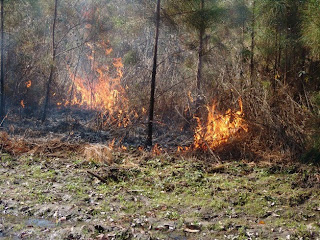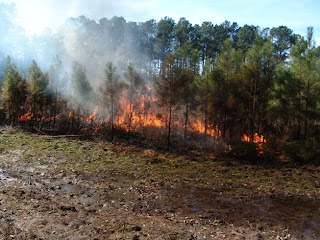

Last Thursday, we spent the whole day burning the Longleaf Pine (Pinus palustris)
stands at the Till property (owned by Audubon SC) southwest of Williams, SC (see Google Earth maps). Longleaf Pine evolved with periodic fires that burned low to the ground, eliminated competing tree species, and exposed the soil to receive Longleaf Pine seeds. Longleaf Pines thick bark protects the trees from low-intensity fires that readily kill or burn other tree species. The key to keeping the fires low in intensity is to ensure that the excess fuel (leaves, needles, dead branches) does not accumulate on the forest floor. As can be seen in the before and after images of the Till burn, fuel was eliminated, Sweetgum and Lobllolly Pine trees were burnt, and the Longleaf Pine trees were given space grown.





Drip torches containing a 4:1 mixture of diesel to gasoline were used to set the fire on the downwind side of the stand, which allowed the fire to burn into the wind at a slower, steadier pace than if the fire were started on the upwind side of the stand. Cotton Rats had to find cover somewhere else and were the most-frequently seen wildlife as they exited the burning areas, although a variety of birds and a family of armadillos were also spotted. Here are some other longleaf-related blog entries.
On Friday, we were at the Sangaree Intermediate School's career day. The former director of a speed-dating service must have set the schedule for the morning. We presented to 175 students in seven 20-minute sessions during three straight hours. We had just enough time between the sessions to reset the PowerPoint. Deja vu was a recurring phenomenon. Hopefully, we were still talking about the swamp in the last sessions! We think we were.
Finally, yesterday the Coastal Master Naturalists Association held their first meeting and began soliciting membership. Beside electing a slate of officers, establishing the bylaws, and planning field activities for the year, we made a Project PROTHO presentation detailing the research and the upcoming opportunities for master naturalists to satisfy some or all of their volunteer service requirements. Here are some previous blog entries regarding Project PROTHO.
Images by Mark Musselman
No comments:
Post a Comment